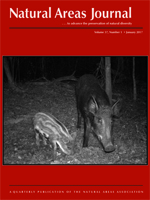Better together …
It's my first day back in my office in nearly three weeks, and I feel strangely refreshed. Likely it was the soul-cleansing experience of hiking in iconic California natural areas such as Yosemite a few weeks ago. Likely it's also because I had some family time this weekend and installed my fall vegetable garden as Florida temperatures reached “chilly” lows in the 50s for the first time this season. Certainly it also reflects the positive vibe from the Natural Areas Conference I just attended. The Natural Areas Association's Executive Director, Lisa Smith, emphasized that conservation, and the NAA, was “better together.” I agree.
I'd assert that “better together” means more than good feelings engendered by holding hands around a campfire. Better together means real collaboration to solve difficult conservation problems. The conference had climate change as a theme, and dealing with climate change is right at the top of the list of challenges that society must grapple with. As natural areas professionals, climate change leads to a series of wicked problems. In California, we heard story after story of how fire suppression and drought have led to megafires of unprecedented size and severity. How do land managers deal with controlling the effects of such fires? When do we decide that these fires have caused regime shifts (e.g., from forests to grasslands) that will make restoration to something like a previous state impossible (or wickedly difficult)? Can we understand which of these post-fire futures will be resilient given ongoing and future climate change?
The fact that individual land managers have to deal with questions of such large scope is our new reality. I am encouraged that an era of real collaboration seems to be going strong and can provide support for difficult decisions. For example, at the conference, presenters often outlined true cooperation between agencies and stakeholders, including stakeholders being included in substantive ways and early in the decision-making process. Gone are the days when a small cadre of experts would recommend paths forward. By taking in a variety of viewpoints and drawing on expertise from a range of disciplines, these dedicated people were creating solutions that should have a greater chance of success and broader support.
I hope the Natural Areas Journal can facilitate all of us being “better together.” Again, I'd like to encourage our members to be involved in Stewardship in Action. These articles allow those on the front lines of natural areas management to share their hard-earned knowledge with others. SIA is for new approaches and techniques, and also for reflection from those nearing retirement that may have a unique perspective on what has worked, and what has not. Anyone can write up a short note for SIA, but the Natural Areas Association also will provide an interviewer to extract pearls of wisdom from someone without the time to write. That someone will be treated as the first author in the SIA note. Also, SIA notes are in their own queue and are likely to appear in print a few months after the interview. We do not assess page charges for SIA notes.
Please let me know if there is a wise person, that you know, who should appear in Stewardship in Action in the Natural Areas Journal. That will make us better together, indeed.





